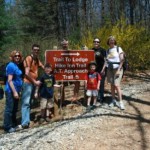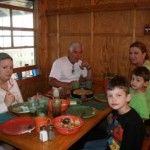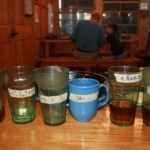A Hike to Hike Inn
 Tuesday, April 20, 2010 at 04:09PM
Tuesday, April 20, 2010 at 04:09PM  Seven of our family recently spent three days in one of the most unique facilities you will find anywhere in Georgia, the Len Foote Hike Inn at Amicalola Falls State Park. The Len Foote Hike Inn is named for Leonard E. Foote, a leading conservationist, biologist and nature photographer who lived and worked in Georgia until his death in 1989. He was a pioneer in the field of wildlife management who was devoted to preserving and studying the beauty of the outdoors.
Seven of our family recently spent three days in one of the most unique facilities you will find anywhere in Georgia, the Len Foote Hike Inn at Amicalola Falls State Park. The Len Foote Hike Inn is named for Leonard E. Foote, a leading conservationist, biologist and nature photographer who lived and worked in Georgia until his death in 1989. He was a pioneer in the field of wildlife management who was devoted to preserving and studying the beauty of the outdoors.


 The best part of the Hike Inn is revealed in the name. Guess what? You can only get to the Inn by “Foote” over a moderate 5 mile hiking trail. We had carefully stowed in our small backpacks only what we needed. Mine contained some clothing, and, yes, I will admit a few granola bars and some smoked almonds. I was a bit sorry I hadn’t included more chocolate, but I did learn to live without it. We found our hike in to be fairly easy, but I was glad that I had brought a bottle of water and by the time we were done, I had drained the last of the by then lukewarm water and was hoping there was a drink machine at the Inn that dispensed icy cold Diet Cokes. I was disappointed in that regard.
The best part of the Hike Inn is revealed in the name. Guess what? You can only get to the Inn by “Foote” over a moderate 5 mile hiking trail. We had carefully stowed in our small backpacks only what we needed. Mine contained some clothing, and, yes, I will admit a few granola bars and some smoked almonds. I was a bit sorry I hadn’t included more chocolate, but I did learn to live without it. We found our hike in to be fairly easy, but I was glad that I had brought a bottle of water and by the time we were done, I had drained the last of the by then lukewarm water and was hoping there was a drink machine at the Inn that dispensed icy cold Diet Cokes. I was disappointed in that regard.
However, I was delighted to find free access to iced tea, lemonade, an endless supply of ice cubes to fill and refill my special reusable green plastic cup courtesy of the Hike Inn, complete with my name on a piece of masking tape to identify it from the dozens of other identical green plastic glasses belonging to the other visitors and all lined up in the windowsills . I was in for more surprises! Once we unpacked our small backpacks and made up our bunk beds, we gathered for the daily tour. About 20 visitors gathered in the lobby of the Hike Inn to start orientation. The Hike Inn is committed to conservation and numerous features were pointed out as we took our tour. To begin with, the Inn has a Gold Level Certification in Leadership in Energy and Environmental Design for and Existing Building by the US Green Building Council. Our tour guide explained how the building was designed to avoid waste and use natural materials to make as small an impact on the site as possible. The Hike Inn has 24 donated photovoltaic panels on the southern side of one of the buildings which produce about 30% of the Hike Inn’s total electricity. Rainwater is harvested in a recycled 55 gallon banana pepper jug to provide water for the butterfly garden and other native plants and trees.
The next feature was located in the bath house. I was anxious to see the composting toilets located there. I was pretty sure that I wasn’t going to find them odor free as I had been led to believe. But the five composting toilet systems work similarly to a leaf pile in the backyard and smell about the same. Rooftop fans circulate fresh oxygen through the systems and that does two things. First the water in the waste is evaporated and second the constant circulation eliminates any odor.
The last feature we visited was my favorite since I, too am in to “Global Worming”. It was the absolutely awesome worm beds! Instead of sending organic waste to a landfill, the Hike Inn recycles its organic waste back into the soil using red wiggler worm beds. They can eat half their weight a day in organic material and produce about as many worm castings, an excellent and expensive organic fertilizer. The Hike Inn’s worm beds hold about 40 to 50 pounds of worms and all the organic waste from the kitchen and the office is composted with ease. Just think of all the leftover grits and junk mail now in their gardens!
And the subject of leftovers brings us to the last subject of the tour. The “Clean Plate Policy”! Guests are encouraged to put on their plate only what they are going to eat. After each meal the plate scrapings for the entire dining room are weighed. The goal is less than four ounces. I was anxious for the first meal to see how our family would respond. Would we be avid conservationists and get a smiley face on the whiteboard? Or would we be reckless wasters and get a frowny face? Not to worry! The food was simple and fantastic. Kids and adults did everything but lick the plate clean. So even in the dining room, thought was given to conserving food that would normally go to waste.
There are a few things you won’t see at the Hike Inn. One is no televisions. No one seems to mind the fact that there are no televisions and no cell phones to disturb the peace. From the sunrise room you can observe the sunrise, play board games, and there are lots and lots of books to borrow and read and puzzles as well. It is amazing how quickly you can adjust to the sounds of birds and the wind rustling the trees. The there thing you won’t see and will probably miss more than the tv is trashcans. Guests are asked to keep the mountain setting clean by leaving only foot prints when visiting. If you pack it in, you are asked to pack it out. I admit to carrying back in my backpack some granola bar wrappers. I figured they didn’t weigh much empty anyway. I was going to pack out a used tea bag, but then I remembered that red wigglers like tea bags! At least I liked to think there was at least one worm who would eat it!
We found the days relaxing and the fifteen miles we hiked those three days seemed to get shorter with each mile we hiked. It does seem certain that the five miles we hiked out were much shorter than the five miles we hiked in. Maybe that is because our quiet days spent in nature made us stop along the way and enjoy the view. “Everything has its beauty, but not everyone sees it”, said Confucious. By the end of the three days we had a much greater appreciation for the beauty we had seen. That’s what a hike can do for you. So the next time you want to take a hike, don’t just hike, “Hike Inn."
Kathy Reets - Co-Founder and Owner


Reader Comments